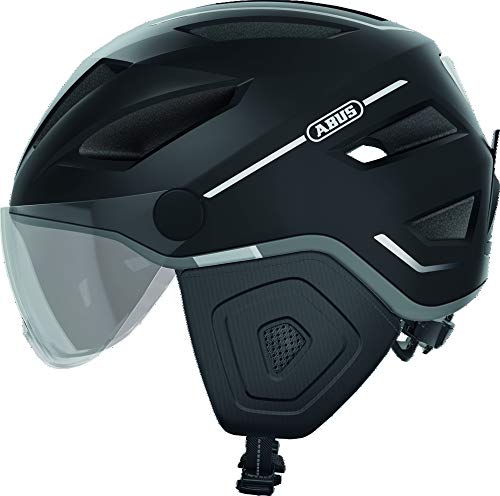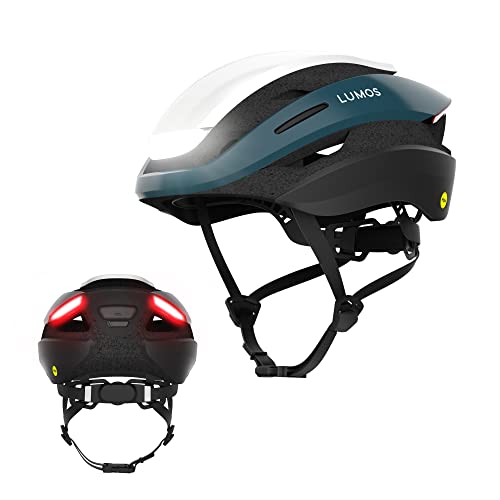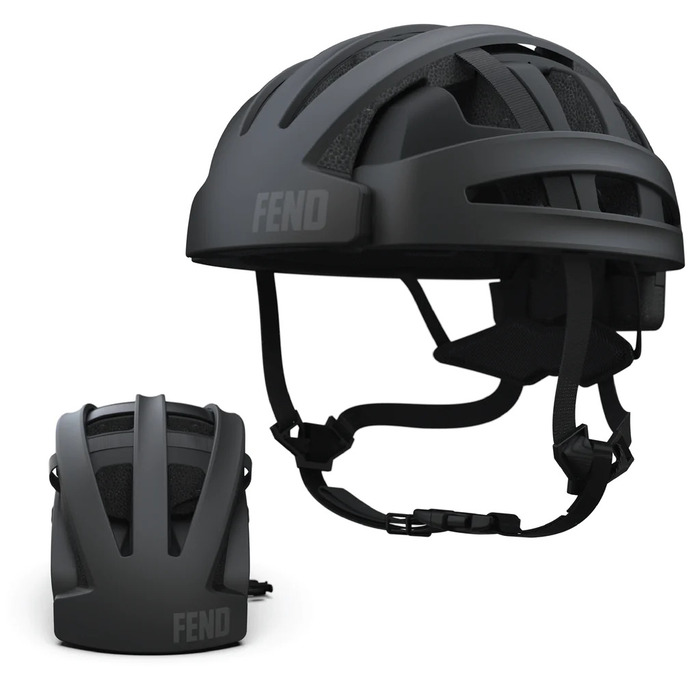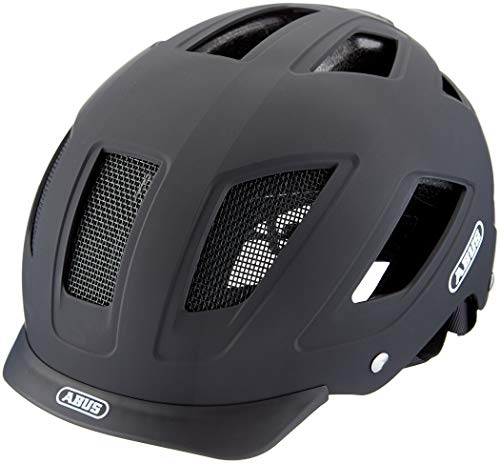Wearing a helmet while cycling reduces the risk of serious accidents by over 70% and can save your life. It is crucial for minimizing head impact in case of a fall, especially at speeds of 15 mph or higher.
Although not mandatory by law for all cyclists, we strongly advocate for the use of helmets — they are ESSENTIAL!
What Are the Best Bike Helmets Available?
Here’s our TOP list of the most durable and rigorously safety-tested bike helmets.
Mips technology. 8 vents. Secret poplock: possibility to thread U-lock or chain lock through. Magnetic clasp. Anti-theft policy. Premium visor. Included 30 lumen USB rechargeable taillight.
Weight: 2,18 lbs | Exterior: Polycarbonate
Abus Pedelec 2.0 - Ace Urban Bike Helmet - High Quality E-Bike Helmet with Rear Light and Visor for City Traffic - Unisex
Weight: 0.9 lbs | Exterior: Polycarbonate
Bicycle helmet with front and rear LED lights. Turn signals. Bluetooth connection. Adult: Men, Women. Water resistant.
Weight: 0.8 lbs | Exterior: Polycarbonate
Foldable by 50% helmet. Comfortable and lightweight. Adjustable fit system and straps. High Impact Absorbing EPS Core. Award winning design. Certified safety first.
Weight: 1,74 lbs | Exterior: ABS and polycarbonate
City Helmet - Rugged Bike Helmet for Everyday Use, ABS Hard Shell - Unisex. LED reflectors with 180° visibility.
Weight : 0.9 lbs | Exterior : ABS
Smart mountain bike with built-in speakers & mic, smartphone connectivity, taillight, 4-way bluetooth intercom
Weight: 2,18 lbs | Exterior: Polycarbonate
Why Wear a Helmet When Cycling?
Wearing a bicycle helmet is crucial for safety. Wearing one reduces the risk of head injury and other serious brain injuries by 80%. We highly recommend introducing helmet-wearing habits to children early on to make it a routine practice.
How to Choose the Right Bike Helmet
#1 Ensure the Helmet Meets Safety Standards for Your Bike Type
One might assume that electrically-assisted bikes require different helmets than conventional bikes, but that’s not true! The helmet approval rules in the USA are consistent for both bike categories.
Your helmet must comply with the USA standards, including:
- Snug fit around your head.
- Full coverage of the skull, including the forehead, temples, back, and top of the head.
- Equipped with high-strength shock absorbers.
Speedbikes are electric bicycles capable of speeds up to 28 mph or more, categorized similarly to mopeds with distinct standards compared to regular electric bikes. Check out my article on speedbike regulations for more information. 😇
Helmets are subject to different standards than electric bikes and must meet motorcycle standards. Certification involves testing for:
- Shock absorption capabilities;
- Retention system effectiveness;
- Field of vision;
- Impact resistance and deformation;
- Chinstrap integrity and abrasion resistance;
- Quality of the main visor;
#2 Helmets Should Be Comfortable
Ventilation and Airflow
Proper ventilation and airflow are crucial aspects of bicycle helmet comfort. A well-ventilated helmet allows the head to breathe without compromising rider safety.
Helmet Padding and Interior
Helmet foams provide enhanced comfort and better contact with the skull. They are also effective for absorbing sweat during exercise. Helmet foams can be replaced or cleaned after extended use using Velcro fasteners, making maintenance easy. Additionally, some helmets feature antibacterial treatments for improved long-term hygiene!
Helmet Weight
Ideally, the helmet should weigh less than 0.88 lbs for optimal comfort.
#3 Choosing the Correct Helmet Size
Selecting the correct size for your bicycle helmet is crucial for safety and comfort. Ensuring a properly fitting helmet is essential for your safety and comfort 😉
Measuring Your Head Size
Use a flexible sewing tape measure to determine your head size. Position it around your forehead and the occipital bone at the back of your head. If you don’t have this type of measuring tape, use a string to measure around your head and then transfer this measurement to a standard tape measure.
Proper Helmet Positioning
Correctly positioning your bicycle helmet on your head for safety and comfort involves the following steps:
- Loosen the adjustment knob to its maximum extent;
- Position the helmet on your head with it sitting level. Tip: Use two fingers above your eyebrows to ensure the helmet is neither too far forward nor too far back;
- Tighten the knob for a secure fit;
- Move your head to ensure the helmet remains in place;
- Ensure the helmet is comfortable without any excessive pressure;
- Adjust the chinstrap to sit comfortably against your face without being too tight;
- Ensure the side straps form a “Y” shape under your earlobes.
Follow these steps to correctly adjust your bicycle helmet! You’re now ready for your bike ride. 😎
#4 Select a Sturdy Bike Helmet
A bicycle helmet consists of four components: the outer shell, the inner layer, additional components, and the design, each serving a unique purpose:
- Outer Shell: The outer shell, typically made of PVC, offers impact protection.
- Inner Layer: Comprising polystyrene beads forming a foam, the inner layer absorbs impacts effectively.
- Additional Components: These components secure the helmet in place, enhancing cyclist safety.
The price of bicycle helmets primarily depends on the materials used; helmets with greater durability, solidity, and lightness command higher prices.
Outer Shell
The outer shell is typically constructed from PVC, polycarbonate, or ABS (acrylonitrile butadiene styrene), and may incorporate carbon reinforcements, each offering unique characteristics:
- PVC: Helmets made of PVC are entry-level, inexpensive, but have a shorter lifespan (about two years) due to sun exposure.
- Polycarbonate: Polycarbonate helmets offer superior resistance and optimal protection, making them prevalent in the market.
- ABS: ABS helmets are highly resistant to temperature fluctuations, durable, lightweight, and shock-resistant.
Inner Layer
The inner layer functions as a shock absorber. It’s primarily composed of polystyrene, which can be reinforced with materials like aramid, kevlar, nylon, or carbon. Why use these materials? Let me explain briefly:
- Aramid: Known for its lightweight, high strength, and thermal properties, aramid is comparable to materials used in bulletproof vests.
- Kevlar: Renowned for its strength, lightweight nature, and exceptional shock absorption, similar to materials used in bulletproof vests.
- Nylon: Durable and resistant to wear, offering optimal shock absorption and thermal stability.
- Carbon Fiber: Known for exceptional rigidity, wear resistance, lightweight properties, and superior strength-to-weight ratio, carbon fiber is among the most costly materials available.
These materials are integrated into the polystyrene during the inner layer design, enhancing helmet safety and performance.
Helmet Exterior
A protective layer of varnish is applied to the helmet exterior to prevent cracking and other damage, ensuring long-lasting aesthetics. 😉
#5 – Helmets Should Ideally Protect Your Eyes
To maximize safety, your helmet ideally includes a visor designed to protect your eyes in various ways:
- Shields against the sun;
- Guards against splashes of pebbles, sand, mud, etc.;
- Provides protection from rain, wind, snow, etc.;
- Offers additional protection in case of a fall.
Therefore, the visor is a valuable asset for optimizing cyclist safety and comfort, especially recommended for electric bike riders! With speeds reaching 15.5 mph or more, eye protection is crucial for preventing splashes and ensuring safety.
Bicycle helmet visors can be integrated or magnetic. A magnetic visor is removable, facilitating replacement in case of scratches. Note: If you prefer a helmet without a visor, consider wearing cycling glasses for eye protection.
#6 High-Tech Features for Bicycle Helmets
Integrated or Mobile Lighting
If you ride your bike at night or during dusk, having an additional light on your helmet is highly recommended! You can choose to attach a red light at the back or a white light at the front of the helmet, or opt for a helmet that comes with built-in lighting. In the latter scenario, the integrated rear light may be red and detachable, or the lighting could consist of LEDs embedded in the helmet shell.
Lighting plays a crucial role in enhancing cyclist safety! For more information, check out my article on choosing powerful bike lights.
Connected Bike Helmets
Nowadays, various innovations are not only enhancing cycling convenience but also impacting the broader world. Specifically, there are helmets equipped with turn signal functionality that alerts motorists and other road users when you’re making a turn. Simply add a button to the handlebars to activate the turn signal—a particularly useful feature during rainy conditions when roads are slippery and it’s hazardous to remove a hand from the handlebars to signal a turn.
Furthermore, with advancing technology, there are connected helmets equipped not only with built-in lighting and a flashing mode but also linked to your phone. This functionality means that in case of a fall and subsequent impact, the helmet sends a signal to a designated person’s phone for immediate notification. Additionally, this system allows for hands-free calls, compliant with legal regulations.
What Is the Cost of a Bike Helmet?
Bicycle helmet prices range from $32 to $430, ensuring options for every budget! Keep in mind that a high-quality helmet typically lasts between 3 to 5 years, whereas a lower-end helmet may require more frequent replacement.
What Is the Lifespan of a Helmet?
Bicycle helmets are categorized as personal protective equipment (PPE) and must meet health and safety standards set by the USA regulations. Therefore, helmet manufacturers are required to specify the product’s date of manufacture (month and year) to determine its expiration date.
To identify the date of manufacture, inspect inside the helmet for a label featuring a factory-like pictogram with the date indicated below it. According to manufacturers, a helmet typically expires 3 to 5 years from its manufacturing date.
Is Wearing a Helmet Mandatory on an Electric Bike?
Similar to wearing a seatbelt when driving, wearing a bicycle helmet should become second nature. Helmets are not mandatory for conventional bicycles or low-speed electric-assist bikes (250 W motor). However, they are mandatory for children aged 12 or under.
For high-speed electric-assist bikes (speedbikes) capable of reaching speeds up to 28 mph, helmets are mandatory due to the increased speed potential.
Selecting the Proper Children’s Bike Helmet
If you’re planning to have your child ride on your electric bike, they need a helmet. Children’s helmets aren’t simply downsized versions of adult helmets; they incorporate several unique features. For instance, the inner shape of children’s helmets is often more rounded to conform better to the shape of their heads. Additionally, helmets designed for young children riding in trailers or cargo bikes have a flat shape at the back of the head to ensure comfort when resting their heads.
It’s important to note that safety standards for children’s helmets are similar to those for adults!
Legal Penalties for Not Wearing a Helmet
Using a high-powered electric bike (motor over 250 W) without a helmet, or failing to provide a helmet for a child, can result in a $100 fine, depending of the State you live in.
Additional Cycling Prohibitions
Cyclists are prohibited from wearing headphones or any other ear-related devices, regardless of the type of bike used. Carrying a mobile phone while cycling is also prohibited. Violators of these rules may face a $150 fine depending of the State you live in.
Additional Safety Tips Besides Helmets
While not mandatory, wearing a high-visibility vest enhances visibility during both day and night, reducing the risk of accidents. It’s highly recommended. For further details on electric bike regulations governing public roads, refer to our comprehensive guide.







